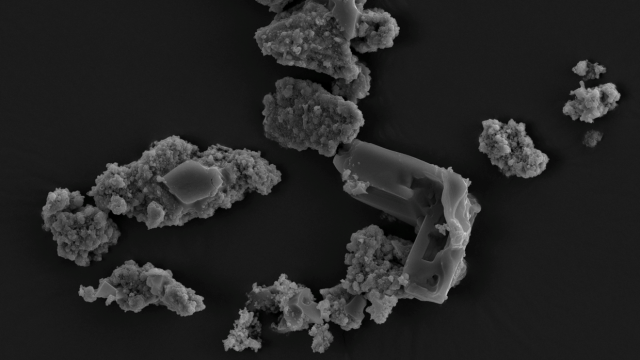Meteorites are an unappreciated food source for a specific metal-loving microorganism, according to new research. The finding could reveal an entirely new chemistry that facilitated the emergence of life on Earth—or possibly even how life got here in the first place.
The beautifully named Metallosphaera sedula is capable of consuming and processing “extraterrestrial material,” as the authors describe it in their new study, published this week in Scientific Reports.
The research, led by astrobiologist Tetyana Milojevic from the University of Vienna, suggests meteorites are a food source for certain chemolithotrophic archaea, a group of bacteria-like microbes that get their energy from inorganic substances, which they do through the wondrous powers of oxidation. What’s more, this discovery could cast new light on the conditions that allowed early life to emerge and evolve on Earth, with meteorites playing a surprisingly important role. More speculatively, the finding could bolster the panspermia hypothesis: the notion that life arrived on Earth from space.
Metallosphaera sedula is so named owing to its metallophilic, or metal-loving, qualities, but the new research suggests a possible rebranding on account of its penchant for meteorites. Indeed, this microbe can harvest energy sources faster from alien rocks than it can from plain old terrestrial minerals.
“We performed this study to reveal microbial fingerprints—metal-containing microfossils—left on rocky extraterrestrial material,” explained Milojevic in an email to Gizmodo. “This should be helpful in tracing biosignatures for the search of life elsewhere in the Universe. If life ever occurred on another planet, similar microbial fingerprints could be still preserved in the geological record.”
This kind of research, she said, could provide astrobiologists with “small hints” on what they should be looking for in the quest for alien life. And indeed, “this was the main motivation of the study,” said Milojevic.
The team examined how this particular organism interacted with NWA 1172, a stony meteorite found in northwest Africa, and the ways in which it altered this extraterrestrial rock. Using several spectroscopy techniques and an electron microscope, the researchers documented the fingerprints left behind by M. sedula.
As the research revealed, M. sedula cells are capable of consuming beneficial meteoric material much faster than terrestrial minerals. These extraterrestrial rocks seem to provide a better energy choice for the microbes, resulting in healthier, fitter cells. NWA 1172 happens to be a very multi-metallic meteorite, containing around 30 different metals, and it’s likely providing an abundance of trace metals that supercharge the microorganism’s metabolic activity and growth, according to the study.
“Sulfide minerals—the ‘terrestrial food’ of M. sedula—provide only few of them [energy sources],” said Milojevic. “Iron from NWA 1172 is used as an energy source to satisfy M. sedula’s bioenergetic needs, as the microbes respire [breathe] on the account of iron oxidation.”
The wide range of other metal elements from NWA 1172 might be used for other metabolic processes, like speeding up vital chemical reactions within cells, explained Milojevic. And because the meteorite is very porous, it could foster M. sedula’s enhanced rate of growth.
It’s important to note that archaea were among the first organisms to grace this good Earth, so it’s possible that M. sedula’s ancestors pulled scarce or beneficial nutrients from meteorites, of which there were plenty back then. Future research should explore this possibility further and explore the ways in which extraterrestrial materials may have enriched Earth’s environment.
“Iron meteorites rich in iron-nickel phosphide could have brought more phosphorus to Earth than occurs naturally, facilitating the evolution of life,” said Milojevic.
Another intriguing possibility raised by this research is the issue of panspermia—the idea that microbial life didn’t arise spontaneously on primordial Earth but was instead delivered from other planets via meteorites. This is still an unproven theory but an interesting one nonetheless, given that scientists have yet to fully elucidate the origin of life on our planet.
Being an astrobiologist, Milojevic is fully aware of this theory, also known as lithopanspermia, but her new research adds a tantalising twist to this possibility. Perhaps an ancestor of M. sedula, or a microorganism like it, was delivered to Earth on meteorites. In such a scenario, these alien microbes would’ve naturally been clinging to metal-rich rocks, but when their home planet got hit by a large celestial object, the rocks—and the microbes—were flung into interstellar space.
And indeed, Milojevic would very much like to explore this possibility.
“In order to support lithopanspermia hypothesis, we plan to test the survival of M. sedula under simulated and real outer space environmental conditions,” Milojevic told Gizmodo, adding that limited funding could prevent such research. “Hopefully, M. sedula grown on different mineral sources will perform a space journey,” she said, noting that a project to expose these microbes to space won’t be “a cheap scientific experimental initiative—money doesn’t grow on trees.”
Fair point. Hopefully Milojevic and her colleagues will be able move forward with this line of inquiry. It’s a possibility that’s too intriguing to ignore.
